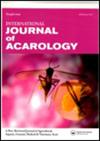迷迭香精油亚致死暴露对威氏钝绥螨种群参数的影响(蜱螨亚纲:植螨科)
IF 1
3区 农林科学
Q3 ENTOMOLOGY
引用次数: 0
摘要
摘要本研究在实验室条件下测定了迷迭香(Lamiaceae)精油LC30和LC50浓度对以一龄西方Frankliniella occidentalis(Pergande)(Thysanoptera:Thripidae)幼虫为食的金雀花(Amblysius swirskii Athias Henriot,Acari:Phytoseidae)生命表参数的副作用。采用年龄阶段、两性生活表法对生活表参数进行评价。分别为对照、LC30和LC50应用获得的净繁殖率(R0)(每个个体8.76、8.68和6.83个卵子)、内在增加率(r)(0.116、0.116和0.098天-1)、有限增加率(λ)(1.123、1.123和1.103天-1),平均世代时间(T)(18.7、18.6和19.6天)和总繁殖力(每个雌性19.77、19.00和17.70个后代)。这项研究的结果表明,使用测试的精油,特别是LC30,与金丝燕组合使用,可以替代合成农药。然而,在纳入综合虫害管理(IPM)策略之前,仍需要进行半实地和实地研究,以评估所测试的精油对西花金龟子和金龟子的影响。本文章由计算机程序翻译,如有差异,请以英文原文为准。
Influence of sub-lethal exposure to Rosmarinus officinalis L. (Lamiaceae) essential oil on demographic parameters of Amblyseius swirskii Athias-Henriot (Acari: Phytoseiideae)
ABSTRACT In this study, the side effects of LC30 and LC50 concentrations of Rosmarinus officinalis L. (Lamiaceae) essential oil on the life table parameters of Amblyseius swirskii Athias-Henriot (Acari: Phytoseiidae) fed on first instar Frankliniella occidentalis (Pergande) (Thysanoptera: Thripidae) larvae were determined under lab conditions. The age-stage, two-sex life table method was used to evaluate the life table parameters. The net reproductive rate (R0) (8.76, 8.68 and 6.83 eggs per individual), intrinsic rate of increase (r) (0.116, 0.116 and 0.098 day −1), finite rate of increase (λ) (1.123, 1.123 and 1.103 day −1), mean generation time (T) (18.7, 18.6 and 19.6 days) and total fecundity (19.77, 19.00, and 17.70 offspring per female) acquired for control, LC30 and LC50 applications, respectively. The findings of this study indicate that using the tested essential oil, particularly the LC30, in combination with A. swirskii can be an alternative to synthetic pesticides. However, semi-field and field studies are still needed to assess the effects of the essential oil tested on F. occidentalis and A. swirskii before incorporating into integrated pest management (IPM) strategies.
求助全文
通过发布文献求助,成功后即可免费获取论文全文。
去求助
来源期刊
CiteScore
2.20
自引率
9.10%
发文量
60
审稿时长
6-12 weeks
期刊介绍:
The International Journal of Acarology has a global readership and publishes original research and review papers on a wide variety of acarological subjects including:
• mite and tick behavior
• biochemistry
• biology
• control
• ecology
• evolution
• morphology
• physiology
• systematics
• taxonomy (single species descriptions are discouraged unless accompanied by additional new information on ecology, biology, systematics, etc.)
All submitted manuscripts are subject to initial appraisal by the Editor. If the English is not of a quality suitable for reviewers, the manuscript will be returned. If found suitable for further consideration, it will be submitted to peer review by independent, anonymous expert referees. All peer review is single blind.

 求助内容:
求助内容: 应助结果提醒方式:
应助结果提醒方式:


